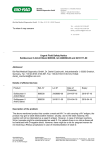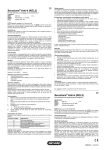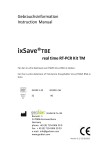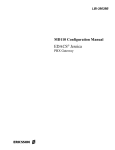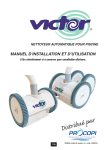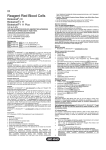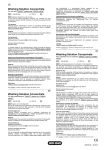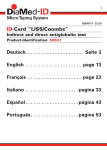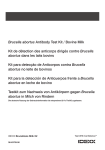Download Solidscreen™ II Anti-D (RH1) Blend Solidscreen™ II Anti-D
Transcript
[UK] Solidscreen™ II Anti-D (RH1) Blend For the determination of the red cell antigen weak D and partial D of RhD negative blood samples Solid phase antiglobulin test Solidscreen™ II Strip [REF] 806 530 5 ml [PRES] Preservative: < 0.1 % NaN3 [IVD] Diagnostic reagent for in vitro use only To be used by trained laboratory personnel only. Symbols are used according to regulation EN 980. Symbols not contained in regulation EN 980 are described. Test purpose Solidscreen™ II Anti-D (RH1) Blend is used with Solidscreen™ II for the detection of weak D and partial D antigens (DVI and DVII). It is used to test samples which have been tested RhD negative with a direct agglutination method. Test principle Solidscreen™ II Anti-D (RH1) Blend reacts with weak D and partial D positive red cells in solidphase method with Solidscreen™ II Strip. The active ingredients Anti-Human Globulin Solidscreen™ II-Donor bind to the cavity wall activated with protein A. The bound antiglobulin molecules bind to sensitized test red cells thus forming a link between the coated test red cells and the cavity wall. A positive reaction shows a layer of cells on the plates’ cavities. Uncoated red cells react with sedimentation after the last centrifugation on the cavity’s bottom1. Reagent As reactive component Solidscreen™ II Anti-D (RH1) Blend contains human monoclonal antibodies of the immunoglobulin class IgG (clone BS221 and H41 11B7) and therefore is suited for testing with Solidscreen™ II. The antibodies are derived from cell culture supernatant and demonstrate the consistent specificity and reproducibility characteristic for monoclonal antibodies. Due to the selection of appropriate clones, weak D and partial D antigens (DVI and DVII) can be detected. Solidscreen™ II Anti-D (RH1) Blend clones BS221 and H41 11B7 (IgG) Material needed but not supplied • Anti-Human Globulin Solidscreen™ II Donor ([REF] 806 516) For further materials please refer to the instructions for use Solidscreen™ II Strip ([REF] 806 521). Antibodies to antibiotics or other reagents Cold antibodies Positive Direct Anti-Globulin Test Please refer to the instructions for use of Solidscreen™ II Strip ([REF] 806 521). In case of questionable results of unknown origin our Bio-Rad Service will assist you (phone: +49-6103-3130-611). Shelf life After opening the vial the product can be stored under proper storage conditions (2...8°C) until the expiry date. The expiry date is printed on the label. Do not use damaged vials. Warning and precautions • Turbidity or other visible changes may indicate a bacterial contamination. In this case the reagent must be discarded. The cause for turbidity must be examined by the manufacturer. • All techniques are to be performed according to the manufacturer’s instructions. Each deviation from these instructions is the sole responsibility of the user and needs to be validated by the user. • Solidscreen™ II Anti-D (RH1) Blend contains human monoclonal antibodies. Because of biotechnological manufacturing of human monoclonal antibodies, a contamination with infectious diseases can be considered impossible. • All materials of human origin used for this product were tested for HbsAg, Anti-HCV, and Anti-HIV-1/-2 and proved to be non-reactive. Nevertheless, all products of human origin must be regarded as potential transmitters of hepatitis, HIV or other infectious diseases. • All test reagents of biological origin must be regarded as potential transmitters of infectious agents. Appropriate safety precautions are recommended. • Used test material must be discarded as hazardous material. Waste management information are in the safety data sheet. • The bovine albumin used for the production of this reagent is purchased from BSE-free sources. Internal quality controls according to national guidelines are recommended at regular intervals. Please also refer to the instructions for use of Solidscreen™ II Strip ([REF] 806521). References (1) AABB Technical Manual, 17th edition. Key: Underline = Addition or significant change ◄= Deletion of text [DE] Solidscreen™ II Anti-D (RH1) Blend Sample material Blood samples should be prepared following general blood sampling guidelines. Fresh, non-hemolytic samples (EDTA blood) should be used. If testing is delayed the EDTA anticoagulated samples should be stored at 2…8°C. EDTA anticoagulated whole blood samples may be tested for up to 7 days following collection. Donor blood stored in citrate anticoagulant may be stored at 2…8°C until the expiration date of the donor unit. Samples to be tested must be centrifuged prior to testing (analogous to the TANGO® optimo and TANGO infinity® user manual). TANGO® optimo and TANGO infinity® systems prepare the red blood cells suspension automatically. Blood sample segments of the blood unit can be used, but have to be prepared according to the TANGO® optimo and TANGO infinity® user manual. ◄ Zum Nachweis des erythrozytären Antigens weak D und Partial D bei RhD negativen Blutproben Festphasen-Antiglobulin-Test Solidscreen™ II Strip Test procedure For each test 50 μl Solidscreen™ II Anti-D (RH1) Blend are pipette to the respective cavity of Solidscreen™ II Strip. Verwendungszweck Solidscreen™ II Anti-D (RH1) Blend wird im Solidscreen™ II-Festphasen-Test zum Nachweis des Blutgruppenmerkmals weak D und partial D (DVI und DVII) bei RhD negativen Blutproben eingesetzt. The exact test procedure is described in the instructions for use of Solidscreen™ II Strip ([REF] 806 521). Performance characteristics and limitations of the method .◄ • Solidscreen™ II Anti-D (RH1) Blend is only for testing blood samples which have been previously typed Rh D negative with a direct agglutination technique. RhD positive blood samples with normal D antigen expression can be interpreted as false negative with Solidscreen™ II Anti-D (RH1) Blend due to agglutination of the red cells instead of solidphase binding. • Solidscreen™ II Anti-D (RH1) Blend might not react with cells in the combination C in trans to D cat VI Type 1 (Cde/cDcat VI e, extremely rare), due to the reduced number of antigens. • Rh33 cannot be detected with Solidscreen™ II Anti-D (RH1) Blend. • Insufficient or inappropriate washing can lead to false negative reactions. Small amounts of residual sera/plasma can neutralize the Anti-Human Globulin. • Strongly lipemic, icteric or microbiologically contaminated samples may lead to false results. • In case of ambiguous results it is recommended to wash red blood cells at least 2 times. • Conditions that may cause false positive result are: Contamination of sample or reagents Autoantibodies Improper storage or preparation of red blood cells [REF] 806 530 5 ml [PRES] Konserviert mit : < 0,1 % NaN3 [IVD] Reagenz zur In-vitro-Diagnostik Nur für die Verwendung durch geschultes Laborpersonal. Symbole werden entsprechend der Norm EN 980 verwendet. In EN 980 nicht enthaltene Symbole sind im weiteren Text erklärt. Testprinzip Solidscreen™ II Anti-D (RH1) Blend reagiert im Festphasentest Solidscreen™ II Strip mit RhD-positiven Erythrozyten. Die wirksamen Bestandteile von Anti-Human-Globulin Solidscreen™ II-Donor binden an Protein A, das auf die Kavitätenwände von Solidscreen™ II Strip aufgebracht ist. Die gebundenen AHG-Moleküle binden wiederum sensibilisierte Erythrozyten und stellen so ein Bindeglied zwischen den beladenen Erythrozyten und der Wand der Kavität dar. Eine positive Reaktion zeigt sich in der Ausbildung eines Zellrasens an der Kavitätenwand. Unbeladene Erythrozyten hingegen sedimentieren nach dem letzten Zentrifugationsschritt auf dem Boden der Kavitäten1. Reagenz Solidscreen™ II Anti-D (RH1) Blend enthält als reaktiven Bestandteil humane monoklonale Antikörper der Immunglobulin-Klassen IgG (Klon BS221 und H41 11B7) und ist daher für die Testung mit Solidscreen™ II geeignet. Die Antikörper werden aus dem Zellkultur-Überstand gewonnen und weisen die für monoklonale Antikörper geltende konstante Spezifität und Reproduzierbarkeit auf. Aufgrund der Auswahl geeigneter Klone werden weak D und partial D (DVI und DVII) erfasst. Solidscreen™ II Anti-D (RH1) Blend Klone BS221 und H41 11B7 (IgG) | 0197 187816/07 – 01/2015 Zusätzlich benötigte Reagenzien und Materialen • Anti-Human Globulin Solidscreen™ II Donor ([REF] 806 516) Für weitere Materialien beachten Sie bitte die Gebrauchsinformation Solidscreen™ II Strip ([REF] 806 521). ausführliche Probenmaterial Blutproben sollten nach allgemeingültigen Entnahmeverfahren gewonnen werden. Es sollten frische, nicht hämolytische Proben (EDTA-Blut) verwendet werden. Verzögert sich die Testdurchführung, sollten EDTA-Proben bei 2…8°C gelagert werden. EDTA-Blute können bis zu 7 Tage nach der Abnahme verwendet werden. In Citrat antikoagulierte Spender Proben können bis zum Verfall der Blutkonserve bei 2…8 °C gelagert werden. Zu testende Proben müssen zentrifugiert werden (Zentrifugation analog der Beschreibung im TANGO® optimo und TANGO infinity® user manual). Im TANGO® optimo und TANGO infinity® wird automatisch eine Erythrozytensuspension hergestellt. Schlauchsegmente von Blutkonserven können verwendet werden, müssen aber analog zum TANGO® optimo und TANGO infinity® user manual aufbereitet werden. ◄ Testdurchführung Pro Bestimmung werden 50 μl Solidscreen™ II Anti-D (RH1) Blend in die vorgesehene Kavität der Solidscreen™ II Strip-Platte pipettiert. Die genaue Testdurchführung entnehmen Sie bitte der ausführlichen Gebrauchsinformation Solidscreen™ II Strip ([REF] 806 521). Leistungsmerkmale und Grenzen der Methode • Nur Proben, die zuvor mit einer Agglutinationsmethode als RhD negativ typisiert wurden, dürfen mit Solidscreen™ II Anti-D (RH1) Blend auf weak D und partial D Merkmale getestet werden. RhD positive Blutproben mit normaler D Ausprägung können im Festphasentest aufgrund von Agglutinaten zu falsch negativen Ergebnissen führen. • Aufgrund der stark verminderten Antigenzahl bei der Konstellation C in trans zu D Cat VI Typ 1 (Cde/cDCat VI e, äußerst selten), kann es unter Umständen zu Reaktionsausfällen kommen. • Rh33 wird nicht von Solidscreen™ II Anti-D (RH1) Blend detektiert. • Unzureichendes Waschen kann zu falsch negativen Reaktionen führen. Geringe Restmengen von Serum/Plasma können das Anti-Human Globulin neutralisieren. • Stark lipämische, ikterische oder mikrobiell kontaminierte Proben können zu unzuverlässigen Testergebnissen führen. • Bei unklaren Ergebnissen wird empfohlen die Erythrozyten mindestens 2 mal zu waschen • Mögliche Ursachen für ein falsch positives Ergebnis sind: Kontamination der Probe oder des verwendeten Reagenz Autoantikörper Unzureichende Lagerung oder Vorbereitung der Erythrozyten Antikörper gegen Antibiotika oder andere Reagenzbestandteile Kälteantikörper Positiver Direkter Anti-Globulin Test. Bitte beachten Sie auch weitere Informationen in der ausführlichen Gebrauchsinformation Solidscreen™ II Strip ([REF] 806 521). Bei zweifelhaften Ergebnissen unklarer Ursache steht der Bio-Rad-Service (Tel. 06103–3130-611) für Rückfragen zur Verfügung. Haltbarkeit Nach Öffnung des Reagenzes ist das Produkt bei sachgemäßer Lagerung (2...8°C) bis zum Ende der angegebenen Laufzeit haltbar. Die Laufzeit ist dem Reagenzienetikett zu entnehmen. Bei beschädigtem Fläschchen darf das Produkt nicht mehr verwendet werden. Warnhinweise und Vorsichtsmaßregeln • Eine Trübung des Produktes kann ein Hinweis auf bakterielle Verunreinigung sein. In diesem Fall darf das Produkt nicht eingesetzt werden, da die Ursache der Trübung durch den Hersteller geklärt werden muss. • Alle Techniken sind nach den Vorgaben des Herstellers anzuwenden. Abweichungen von den vom Hersteller angegebenen Abarbeitungstechniken sind vom Anwender und in Verantwortung des Anwenders zu validieren. • ◄Solidscreen™ II Anti-D (RH1) Blend enthält humane monoklonale Antikörper. Durch die biotechnologische Herstellung der humanen monoklonalen Antikörper ist das Risiko einer Kontamination durch infektiöse Krankheitserreger nahezu ausgeschlossen. • Alle verwendeten Materialien humanen Ursprungs werden auf HbsAg, Anti-HCV und Anti-HIV-1/-2 geprüft und müssen sich als nicht reaktiv erweisen. Dennoch sollten alle Produkte humanen Ursprungs als potentielle Überträger von Hepatitis, HIV oder anderen infektiösen Krankheitserregern betrachtet werden. • Alle Testreagenzien sollten als potentiell infektiös gehandhabt und die entsprechenden Vorsichtsmaßnahmen getroffen werden. • Gebrauchtes Testmaterial muss als Gefahrgut betrachtet werden. Informationen zur Entsorgung verwendeter Reagenzien sind dem Sicherheitsdatenblatt zu entnehmen. • Das bei der Herstellung der Reagenzien verwendete Rinderalbumin wird nur aus BSE-freien Beständen bezogen. Der Anwender muss eine regelmäßige interne Qualitätskontrolle durchführen. Es gelten die jeweiligen nationalen Richtlinien. Bitte beachten Sie auch den Hinweis in der ausführlichen Gebrauchsinformation Solidscreen™ II Strip ([REF] 806 521). MBio-Rad Medical Diagnostics GmbH Industriestr. 1, D-63303 Dreieich, Germany Tel.: +49-6103-3130-0, Fax: +49-6103-3130-724 www.bio-rad.com, [email protected] Literatur (1) AABB Technical Manual, 17th edition. Schlüssel: Unterstrichen = Zusatz oder wichtige Änderung ◄= Entfernter Text [FR] TM Solidscreen II Anti-D (RH1) Pour la détermination des antigènes érythrocytaires D faible et D partiel dans des échantillons de sang RhD négatif TM Test à l’antiglobuline en phase solide Solidscreen II Strip [REF] 806 530 5 ml [PRES] Solution de conservation : < 0,1 % NaN3 [IVD] Réactif pour usage diagnostique in vitro Le test ne doit être utilisé que par le personnel de laboratoire formé à cet effet. Les symboles sont utilisés conformément à la norme EN 980. Les symboles non visés dans la norme EN 980 sont expliqués dans le texte. Application SolidscreenTM II Anti-D (RH1) est utilisé avec le test en phase solide SolidscreenTM II dans le but de rechercher le marqueur de groupe sanguin D faible et D partiel (DVI et DVII) dans des échantillons de sang RhD négatifs. Principe du test SolidscreenTM II Anti-D (RH1) réagit avec les érythrocytes RhD-positifs dans la procédure de test en phase solide utilisant SolidscreenTM II Strip. Les éléments actifs de l’antiglobuline humaine Solidscreen™ II-Donor se fixent aux parois des cupules coatées avec de la protéine A de SolidscreenTM II Strip. Les molécules d'antiglobuline humaine ainsi liées s'unissent à leur tour avec les érythrocytes de donneurs de test sensibilisés et constituent un lien entre les érythrocytes chargés d'anticorps et la paroi de la cupule. La réaction est positive lorsqu’un tapis de cellules se forme sur la paroi de la cupule. Par contre, les érythrocytes non chargés se déposent au fond de la cupule après le dernier palier de centrifugation1. Réactifs SolidscreenTM II Anti-D (RH1) contient un réactif à base d’anticorps monoclonaux humains de la classe d’immunoglobulines IgG (clones BS221 et H41 11B7) et c’est pourquoi il convient à une procédure de test avec SolidscreenTM II. Les anticorps sont prélevés dans le surnageant des cultures de cellules et une spécificité et une reproductibilité pour les anticorps monoclonaux. Grâce à la sélection de clone adaptés, le D faible et le D partiel (DVI et DVII) sont détectés. SolidscreenTM II Anti-D (RH1) Clones BS221 et H41 11B7 (IgG) Réactifs et matériel supplémentaires • Anti-Human Globulin SolidscreenTM II Donor ([REF] 806 516) Pour les autres matériels, veuillez vous reporter aux informations complètes à des utilisateurs de SolidscreenTM II Strip ([REF] 806 521). Échantillons Les échantillons de sang doivent être collectés prelevés selon la procédure de prélèvement habituelle. Il convient d'utiliser du sang frais non hémolysé (prélevé sur EDTA) des échantillons. Si le test ne peut être réalisé immédiatement, les échantillons prélevés sur EDTA doivent être conservés à une température comprise entre 2 et 8 °C. Le sang conservé sur EDTA peut être utilisé durant 7 jours maximum après son prélèvement. Les échantillons de donneur et traités au citrate peuvent être stockés jusqu’à péremption de la poche à une température comprise entre 2 et 8 °C. Les échantillons à tester doivent être centrifugés (la centrifugation s’effectue de manière analogue à la description faite dans le manuel d’utilisateur TANGO® optimo et TANGO infinity®). TANGO® optimo et TANGO infinity® préparent automatiquement une suspension des érythrocytes. Les segments de tubes d’échantillons de sang peuvent être utilisés, mais ils doivent être préparés conformément au manuel d’utilisateur de TANGO® optimo et TANGO infinity®. Mode opératoire Pour chaque test, 50µl de Solidscreen™ II Anti-D Blend doivent être pipetés et déposés dans chaque puits de la plaque Solidscreen™ II. La procédure exacte du test est décrite dans les instructions d’utilisation Solidscreen II Strip ([REF] 806 521). Performances et limites de la méthode • Seuls les échantillons dépistés RhD négatifs (en technique TIA) peuvent être testés avec SolidscreenTM II Anti-D (RH1). Des échantillons RHD positifs, avec une expression antigénique D normale, peuvent donner un résultat faussement négatif lors du test de phase solide. Solidscreen™ II Anti-D Blend ne devraient pas réagir avec les cellules de • combinaison C en TRANS D cat VI Type 1 (Cde/cDCat VI e, extrêmement rare) • Le Rh33 n’est pas détecté SolidscreenTM II Anti-D (RH1). • Un lavage insuffisant peut conduire à des résultats faussement négatifs. Des quantités résiduelles faibles de sérum / plasma peuvent neutraliser l’antiglobuline humaine. | 0197 187816/07 – 01/2015 • Si les échantillons sont fortement lipémiques, ictériques ou contaminés par des microbes, cela peut conduire à des résultats de test non fiables. • En cas de résultats douteux, il est recommandé de laver les érythrocytes au moins 2 fois • Les causes possibles d’un résultat faussement positif sont les suivantes : Contamination de l’échantillon ou du réactif utilisé Autoanticorps Stockage ou préparation incorrects des érythrocytes Présence d’anticorps dirigés contres les antibiotiques ou d’autres éléments qui composent les réactifs Anticorps froids Test aux antiglobulines direct positif. Veuillez vous reporter également aux informations complètes du manuel complet à l’intention des utilisateurs de SolidscreenTM II Strip ([REF] 806 521). En cas de résultats douteux dont la cause ne serait pas évidente, veuillez vous adresser au Bio-Rad-Service (Tél. +49-6103-3130-611) qui se tient à votre disposition. Conservation Après ouverture du réactif, le produit peut être conservé jusqu’à sa date limite d’utilisation dans des conditions adaptées (2 à 8 °C). Cette date limite est indiquée sur l’étiquette du réactif. Il ne faut jamais utiliser de produit dont le flacon est endommagé. Avertissements et précautions • Si le produit est trouble, cela peut indiquer une contamination bactérienne. Dans ce cas, le produit en question ne doit pas être utilisé, car l’origine de ce phénomène doit être examinée par le fabricant. • Toutes les techniques utilisées doivent respecter les consignes données par le fabricant. Toute dérogation aux dispositions du fabricant concernant la technique de conduite du test doit être validée par l'utilisateur lui-même et sous sa propre responsabilité. • Solidscreen™ II Anti-D (RH1) contient des anticorps monoclonaux humains. La méthode de fabrication biotechnologique des anticorps monoclonaux humains exclut presque toute contamination par un germe de maladie infectieuse. • Tous les matériaux d'origine humaine sont soumis à un contrôle de dépistage HbsAg, anti-HCV et anti-HIV-1/-2 et doivent s'avérer non réactifs. Cependant, il convient de considérer tout produit d’origine humaine comme étant potentiellement porteur du virus de l'hépatite, du VIH 1 / 2 ou d'autres agents pathogènes. • Il convient donc de considérer tout réactif de test comme étant potentiellement infectieux et de prendre les mesures de sécurité appropriées. • Le matériel de test utilisé doit être considéré comme dangereux. Pour connaître la procédure d’élimination des réactifs utilisés, consulter la fiche de données de sécurité. • L'albumine d'origine bovine utilisée pour la fabrication des réactifs provient de stocks certifiés dépourvus du virus de l'ESB. L’utilisateur est tenu d'effectuer régulièrement des contrôles de qualité en interne. Ce sont les directives nationales correspondantes qui s’appliquent. Veuillez également vous reporter aux consignes indiquées dans les informations complètes à l’intention des utilisateurs de SolidscreenTM II Strip. Bibliographie (1) AABB Technical Manual, 17th edition Clé : Souligner = Addition ou modification significative ◄= Effacement du texte TM Solidscreen [ES] II Anti-D (RH1) Blend Para la determinación del antigeno eritrocitario D débil y D Parcial en muestras de sangre RhD negativas TM Prueba de antiglobulina en fase sólida Solidscreen II Strip [REF] 806 530 5 ml [PRES] conservado con : < 0,1 % NaN3 [IVD] Reactivo únicamente para el diagnóstico in vitro Sólo para el uso por personal de laboratorio capacitado. Los símbolos se usan conforme a la norma EN 980. Símbolos no contenidos en EN 980 se explican en este texto. Fin de aplicación SolidscreenTM II Anti-D (RH1) Blend se utiliza en la prueba de fase sólida SolidscreenTM II para determinar la característica del grupo sanguíneo D débil y D Parcial (DVI y DVII) en muestras de sangre RhD negativas. Principio de la prueba SolidscreenTM II Anti-D (RH1) Blend reacciona con eritrocitos RhD positivos en la prueba de fase sólida SolidscreenTM II Strip. Los componentes eficaces de la globulina antihumana SolidscreenTM II-Donor se unen a la proteína A que está recubriendo las paredes de los micropozos del SolidscreenTM II Strip. Las moléculas AHG ligadas enlazan, a su vez, eritrocitos sensibilizados y representan así un eslabón entre los eritrocitos sensibilizados con anticuerpos y la pared del micropozo. Una reacción positiva se muestra en la formación de una capa celular en la pared del micropozo. En MBio-Rad Medical Diagnostics GmbH Industriestr. 1, D-63303 Dreieich, Germany Tel.: +49-6103-3130-0, Fax: +49-6103-3130-724 www.bio-rad.com, [email protected] cambio, eritrocitos no cargados sedimentan en el fondo de los micropozos después del último paso de centrifugación1. Reactivo SolidscreenTM II Anti-D (RH1) Blend contiene como componente reactivo anticuerpos monoclonales humanos de las clases de inmunoglobulina IgG (clonas BS221 y H41 11B7) y, por tanto, es adecuado para la prueba con SolidscreenTM II. Los anticuerpos se obtienen del sobrenadante del cultivo celular y presentan una espeficificidad y reproducibilidad constante, válida para anticuerpos monoclonales. En virtud de la elección adecuada de clonas se detectan los antígenos D débil y D Parcial (DVI y DVII). SolidscreenTM II Anti-D (RH1) Blend clonas BS221 y H41 11B7 (IgG) Reactivos y materiales requeridos adicionalmente pero no suministrados • Anti-Globulina humana SolidscreenTM II Donor ([REF] 806 516) Para otros materiales consulte nuestra información detallada sobre el uso de SolidscreenTM II Strip ([REF] 806 521). Material de muestras Las muestras de sangre deberían ser obtenidas según el método de extracción de validez general. Se deben utilizar muestras de frescas (sangre con EDTA) y no hemolizadas. Si la ejecución de la prueba se retarda, las muestras EDTA deberían guardarse a 2...8 ºC. Las sangres con EDTA pueden ser utilizadas hasta 7 días después de la extracción. Las muestras de donadores anticoaguladas con citrato pueden ser guardadas hasta la caducidad de la conserva de sangre a 2...8 ºC. Las muestras que han de analizarse tienen que ser centrifugadas (centrifugación análoga a la descrita en el manual de usuario TANGO® optimo y TANGO infinity®). En TANGO® optimo y TANGO infinity® se elabora automáticamente una suspensión de eritrocitos. Segmentos provenientes de las unidades de sangre pueden ser utilizadas, pero tienen que ser preparadas como se describe en el manual de usuario TANGO® optimo y TANGO infinity®. Procedimiento Por cada determinación se pipetean 50 μl de SolidscreenTM II Anti-D (RH1) Blend en el micropozo previsto de la placa de tiras SolidscreenTM II. Consulte la ejecución exacta de la prueba en el inserto del SolidscreenTM II Strip ([REF] 806 521). Características de funcionamiento y límitaciones del método • Sólo muestras que fueron tipificadas previamante con un método de aglutinación directo como RhD negativas pueden ser analizadas con TM Solidscreen II Anti-D (RH1) Blend. Muestras de sangre RhD positivas con expresión normal del antpigeno D pueden con-ducir a resultados falsos negativos con SolidscreenTM II Anti-D (RH1) Blend debido a la formación de aglutinados en lugar de la unión a la fase sólida. • SolidscreenTM II Anti-D (RH1) Blend puede no reaccionar con células con la configuración C en trans con respecto a D Cat VI tipo 1 (Cde/cDCat VI e, extremadamente rara), debido al número considerablemente reducido de antigenos • El antígeno Rh33 no es detectado por SolidscreenTM II Anti-D (RH1) Blend. • Un lavado insuficiente o inapropiado puede conducir a reacciones erróneamente negativas. Cantidades residuales pequeñas de suero/plasma pueden neutralizar la globulina antihumana. • Muestras lipémicas, ictéricas ó contaminadas por microbios pueden conducir a falso resultados de la prueba. • En caso de resultados confusos se recomienda lavar los eritrocitos por lo menos dos veces. • Posibles causas de un resultado erróneamente positivo son: Contaminación de la muestra o del reactivo utilizado Auto-anticuerpos Almacenamiento o preparación inapropiados de los eritrocitos Anticuerpos contra antibióticos u otros componentes reactivos Anticuerpos fríos Prueba de anti-globulina directa humana positiva. Favor de referirse a las instrucciones de uso del SolidscreenTM II Strip ([REF] 806 521). En caso de resultados dudosos de causa confusa, está a disposición el Bio-Rad-Service (Tel. +49-6103-3130-611) para consultas. Estabilidad Después de abrir el reactivo, el producto se conserva hasta el final de la caducidad indicada si se guarda apropiadamente (2...8 ºC). La caducidad aparece en la etiqueta del reactivo. Si el frasco está dañado, no se deberá utilizar más el producto. Advertencias y precauciones • Un enturbiamiento del producto puede ser una señal de contaminación bacteriana. En tal caso no se deberá utilizar el producto, ya que la causa del enturbiamiento tiene que ser aclarado por el fabricante. • Todas las técnicas se aplicarán según las prescripciones del fabricante. Diferencias de las técnicas de procesamiento indicadas por el fabricante tienen que ser validadas por el usuario y bajo su responsabilidad. • Solidscreen II Anti-D (RH1) Blend contiene anticuerpos monoclonales humanos. Debido a la elaboración biotecnológica de los anticuerpos mono- | 0197 187816/07 – 01/2015 clonales humanos, el riesgo de una contaminación por agentes patógenos infecciosos está casi descartado. • Todos los materiales de origen humano utlizados son analizados con respecto a HbsAg, Anti-HCV y Anti-HIV-1/-2 y tienen que demostrar no ser reactivos. No obstante, todos los productos de origen humano deben considerarse como transmisores potenciales de hepatitis, VIH u otros agentes patógenos infecciosos. • Todos los reactivos del test deberían ser manejados como potencialmente infecciosos y adoptarse las respetivas medidas de precaución. • El material usado en la prueba tiene que considerarse como material peligroso. Información acerca de la eliminación de reactivos utilizados se puede obtener de la hoja de seguridad. • La albúmina bovina utilizada en la fabricación de este reactivo se adquiere únicamente de fuentes libres de EEB. El usuario tiene que efectuar un control de calidad interno en intervalos regulares. Se aplicarán las respectivas directivas nacionales. Favor de referirse a las instrucciones de uso del del SolidscreenTM II Strip.a Referencias (1) AABB Technical Manual, 17th edition Clave: Subrayado = Adición o cambio significativo ◄= Texto borrado [IT] TM Solidscreen II Anti-D (RH1) Blend Per la determinazione dell’antigene eritrocitario weak D e partial D di campioni di sangue RhD negativi TM Test dell’antiglobulina in fase solida Solidscreen II Strip [REF] 806 530 5 ml [PRES] Conservato con: < 0,1 % NaN3 [IVD] Reagente per uso diagnostico in vitro Il test deve essere utilizzato solo da personale di laboratorio esperto e addestrato. I simboli vengono utilizzati secondo la normativa EN 980. I simboli non riportati nella normativa EN 980 sono descritti di seguito nel testo. Finalità d’uso SolidscreenTM II Anti-D (RH1) Blend viene utilizzato con il test in fase solida SolidscreenTM II per la determinazione dell’antigene D weak e partial D (DVI e DVII) con campioni di sangue RhD negativi. Principio del test SolidscreenTM II Anti-D (RH1) Blend reagisce con gli eritrociti RhD positivi nel test in fase solida SolidscreenTM II Strip. I componenti attivi presenti in Anti-Human-Globulin SolidscreenTM II-Donor si legano alla proteina A depositata sulle pareti del pozzetto di SolidscreenTM II Strip. Le molecole di antiglobulina umana legate si legano a loro volta agli eritrociti sensibilizzati formando un legame tra gli eritrociti sensibilizzati e la parete del pozzetto. Una reazione positiva si manifesta con la formazione di un tappeto cellulare sulla parete del pozzetto. Gli eritrociti non rivestiti invece sedimentano dopo l'ultimo ciclo di centrifugazione sul fondo del pozzetto1. Reagente SolidscreenTM II Anti-D (RH1) Blend è composto da una miscela di anticorpi monoclonali umani reattivi della classe immunoglobulinica IgG (clone BS221 e H41 11B7) ed è quindi adatto per l’esame con SolidscreenTM”. II. Gli anticorpi si ottengono da surnatante di colture cellulari e presentano la specificità e riproducibilità costanti degli anticorpi monoclonali. Grazie alla selezione di cloni adatti viene rilevato weak D e partial D (DVI e DVII). SolidscreenTM II Anti-D (RH1) Blend Cloni BS221 e H41 11B7 (IgG) Reagenti e materali supplementari necessari • Anti-Human Globulin SolidscreenTM II Donor ([REF] 806 516) esecuzione del test, fare riferimento alle istruzioni d’uso dettagliate relative al test SolidscreenTM II Strip ([REF] 806 521). Caratteristiche delle prestazioni e limiti del metodo • Soltanto i campioni che sono stati precedentemente tipizzati come RhD negativi possono essere testati con SolidscreenTM II Anti-D (RH1) Blend per weak D e partial D. Campioni di sangue RhD positivi con normale espressione dell’antigene D possono essere interpretati come falsi negativi a causa dell’agglutinazione. • Solidscreen™ II Anti-D (RH1) Blend potrebbe non reagire con le cellule del genotipo C in trans con D Cat VI Tip 1 (Cde/cDCat VI e, estremamente raro), per il ridotto numero di antigeni. TM • Rh33 non viene rilevato da Solidscreen II Anti-D (RH1) Blend. • Il lavaggio insufficiente può condurre a reazioni false negative. Piccole quantità residue di siero/plasma possono neutralizzare l’antiglobulina umana. • I campioni fortemente lipemici, itterici o con contaminazione microbica possono dare risultati falsati. • In caso di risultati non chiari consigliamo di lavare almeno due volte gli eritrociti. • Possibili cause per un risultato falso positivo sono: Contaminazione del campione o del reagente utilizzato Autoanticorpi Conservazione o preparazione impropria degli eritrociti Anticorpi contro antibiotici o altri reagenti Anticorpi freddi Test dell’antiglobulina diretto positivo Fare riferimento alle ulteriori istruzioni d’uso dettagliate relative al test SolidscreenTM II Strip ([REF] 806 521). In caso di risultati dubbi con causa ignota è possibile contattare l’assistenza Bio-Rad (tel. +49-6103-3130-611) per chiarimenti. Stabilità Una volta aperto il flacone, il prodotto può essere conservato in condizioni appropriate (2...8°C) fino alla data di scadenza indicata. La data di scadenza è riportata sull’etichetta del reagente. Se i flaconi dovessero risultare danneggiati, il prodotto non va più utilizzato Avvertenze e precauzioni • L'eventuale presenza di torbidità nel prodotto può essere indice di contaminazione batterica. In tal caso il prodotto non va utilizzato in quanto spetta al produttore chiarire la causa della torbidità. • Tutte le tecniche vanno impiegate secondo le istruzioni del produttore. Eventuali deviazioni rispetto alle istruzioni del produttore vanno validate dall'utente sotto la sua completa responsabilità. • Solidscreen™ II Anti-D (RH1) Blend contiene anticorpi umani monoclonali. Grazie alla produzione biotecnologica degli anticorpi monoclonali umani, il rischio di contaminazione con agenti patogeni infettivi può essere quasi escluso. • Tutti i materiali di origine umana impiegati sono stati sottoposti ad analisi per la ricerca di HbsAg, anti-HCV e anti-HIV-1/-2 e sono risultati non reattivi. Tuttavia, tutti i prodotti di origine umana vanno considerati come potenziali portatori di epatite, HIV o di altri agenti patogeni infettivi. • Tutti i reagenti devono essere considerati come potenzialmente infettivi e vanno adottate adeguate misure precauzionali. • Il materiale d‘esame utilizzato deve essere considerato come materiale pericoloso. Per le informazioni inerenti allo smaltimento di reagenti usati fare riferimento alla scheda di sicurezza. • L'albumina di origine bovina impiegata per la preparazione dei reagenti viene acquistata unicamente da fornitori certificati contro la BSE. L'utente deve eseguire un regolare controllo di qualità interno. Valgono le rispettive direttive nazionali vigenti. Fare riferimento anche alle ulteriori istruzioni d’uso dettagliate relative al test SolidscreenTM II Strip. Bibliografia (1) AABB Technical Manual, 17th edition Chiave: Sottolineatura = aggiunta o cambiamento significativo ◄= Cancellazione di testo Per altri materiali fare riferimento alle istruzioni d’uso dettagliate relative al test SolidscreenTM II Strip ([REF] 806 521). Materiale in esame I campioni di sangue vanno prelevanti secondo le procedure generalmente valide. Devono essere utilizzati campioni freschi, che non presentino emolisi (sangue con EDTA). Se l’esecuzione del test viene ritardata i campioni con EDTA devono essere conservati a 2…8°C. I campioni di sangue con EDTA possono essere utilizzati fino a dopo 7 giorni dal prelievo. I campioni di sangue con citrato dei donatori possono essere conservati fino alla scadenza del sangue a 2…8 °C. I campioni da testare devono essere centrifugati (secondo la descrizione del TANGO® optimo e TANGO infinity® user manual). Con TANGO® optimo e TANGO infinity® viene effettuata automaticamente una sospensione di eritrociti. Può essere utilizzato sangue dei segmenti delle sacche, ma deve essere preparato secondo il TANGO® optimo e TANGO infinity® user manual. Esecuzione del test Per ciascun ciclo analitico vengono dispensati 50 μl di SolidscreenTM II Anti-D (RH1) Blend nel rispettivo pozzetto di SolidscreenTM II Strip. Per l’esatta MBio-Rad Medical Diagnostics GmbH Industriestr. 1, D-63303 Dreieich, Germany Tel.: +49-6103-3130-0, Fax: +49-6103-3130-724 www.bio-rad.com, [email protected] | 0197 187816/07 – 01/2015




